Comparative Analysis: DMARDs Plus Exercise for Rheumatoid Arthritis
VerifiedAdded on 2023/04/07
|11
|2416
|124
Report
AI Summary
This report investigates the effectiveness of combining Disease-Modifying Anti-Rheumatic Drugs (DMARDs) with moderate physical exercise for adult patients with rheumatoid arthritis (RA) of five years or more, comparing it to DMARDs alone in terms of pain relief. The study highlights the potential benefits of an integrated approach to RA management, contrasting pharmacologic treatments like DMARDs, NSAIDs, and immunosuppressants with non-pharmacologic strategies such as exercise, diet, and physical therapy. The research problem focuses on whether the combination of DMARDs and exercise yields more effective pain relief than DMARDs alone, with a conceptual framework defining independent variables (DMARDs with exercise vs. DMARDs only) and the dependent variable (pain relief) measured using a numeric rating scale. The methodology involves randomized and controlled trials, monitoring patients' progress, and employing statistical software like SPSS or R for data analysis, including ANOVA to establish differences between the two treatment groups over time. The project emphasizes the importance of project management, addresses limitations such as resource and time constraints, and underscores the potential impact on improving the lives of RA patients and informing future research.
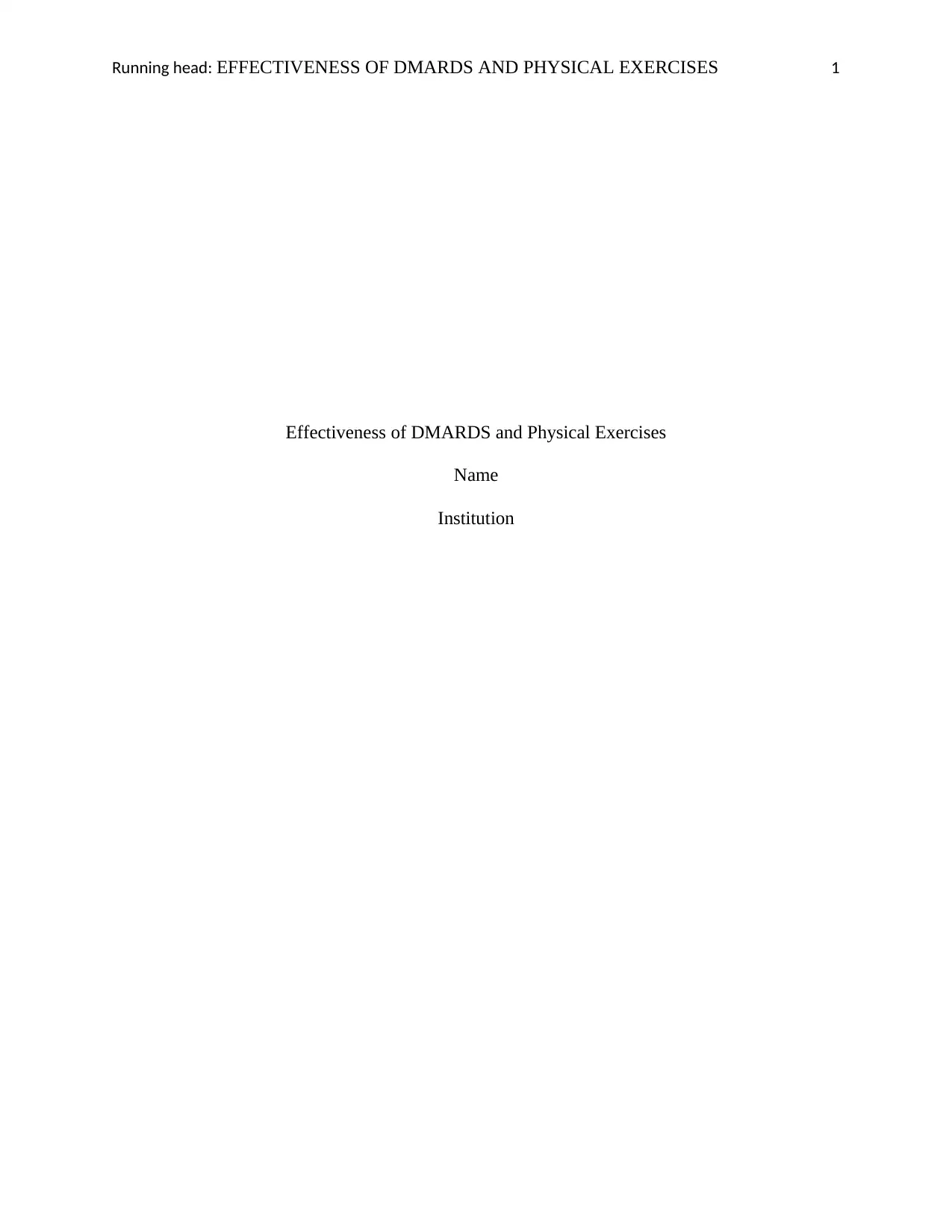
Running head: EFFECTIVENESS OF DMARDS AND PHYSICAL EXERCISES 1
Effectiveness of DMARDS and Physical Exercises
Name
Institution
Effectiveness of DMARDS and Physical Exercises
Name
Institution
Paraphrase This Document
Need a fresh take? Get an instant paraphrase of this document with our AI Paraphraser
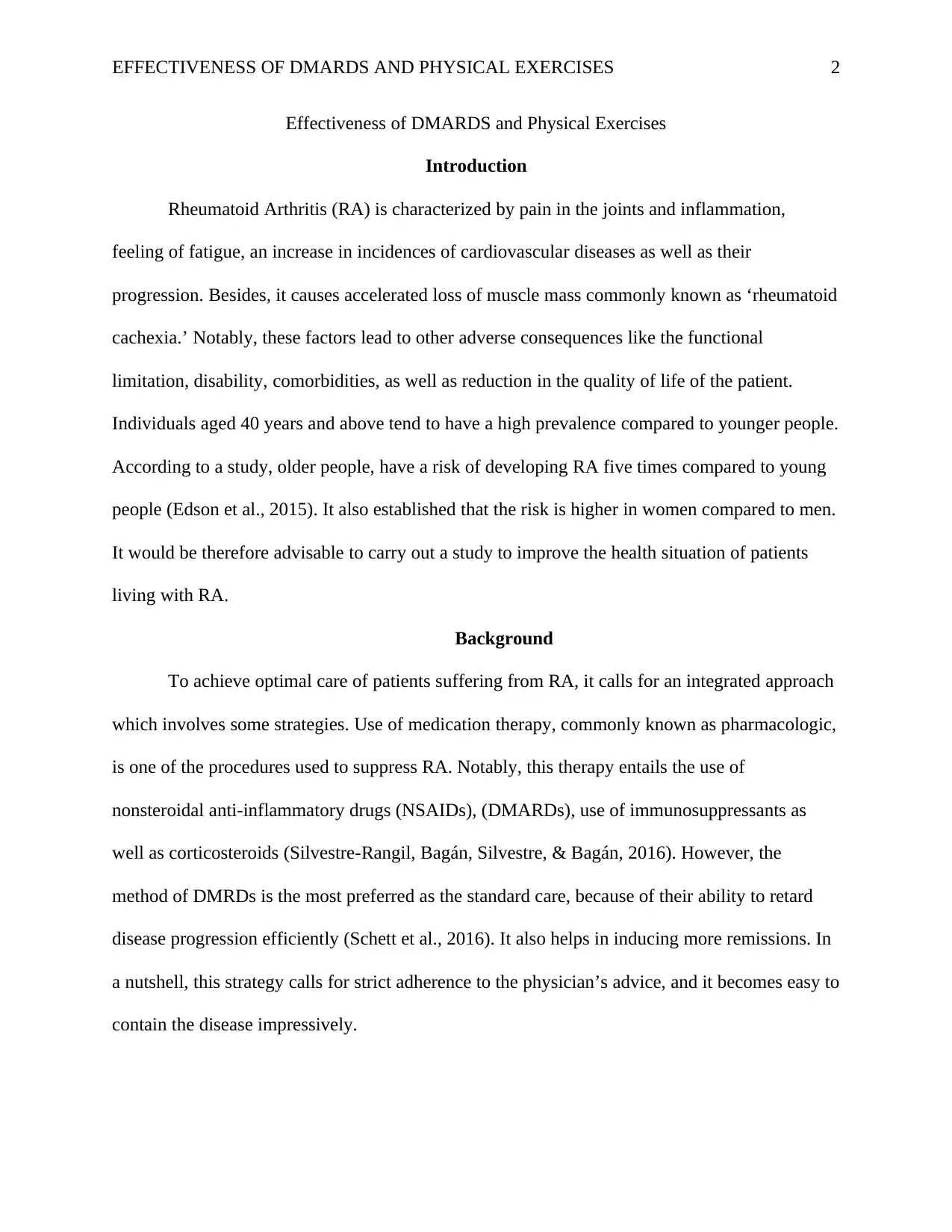
EFFECTIVENESS OF DMARDS AND PHYSICAL EXERCISES 2
Effectiveness of DMARDS and Physical Exercises
Introduction
Rheumatoid Arthritis (RA) is characterized by pain in the joints and inflammation,
feeling of fatigue, an increase in incidences of cardiovascular diseases as well as their
progression. Besides, it causes accelerated loss of muscle mass commonly known as ‘rheumatoid
cachexia.’ Notably, these factors lead to other adverse consequences like the functional
limitation, disability, comorbidities, as well as reduction in the quality of life of the patient.
Individuals aged 40 years and above tend to have a high prevalence compared to younger people.
According to a study, older people, have a risk of developing RA five times compared to young
people (Edson et al., 2015). It also established that the risk is higher in women compared to men.
It would be therefore advisable to carry out a study to improve the health situation of patients
living with RA.
Background
To achieve optimal care of patients suffering from RA, it calls for an integrated approach
which involves some strategies. Use of medication therapy, commonly known as pharmacologic,
is one of the procedures used to suppress RA. Notably, this therapy entails the use of
nonsteroidal anti-inflammatory drugs (NSAIDs), (DMARDs), use of immunosuppressants as
well as corticosteroids (Silvestre-Rangil, Bagán, Silvestre, & Bagán, 2016). However, the
method of DMRDs is the most preferred as the standard care, because of their ability to retard
disease progression efficiently (Schett et al., 2016). It also helps in inducing more remissions. In
a nutshell, this strategy calls for strict adherence to the physician’s advice, and it becomes easy to
contain the disease impressively.
Effectiveness of DMARDS and Physical Exercises
Introduction
Rheumatoid Arthritis (RA) is characterized by pain in the joints and inflammation,
feeling of fatigue, an increase in incidences of cardiovascular diseases as well as their
progression. Besides, it causes accelerated loss of muscle mass commonly known as ‘rheumatoid
cachexia.’ Notably, these factors lead to other adverse consequences like the functional
limitation, disability, comorbidities, as well as reduction in the quality of life of the patient.
Individuals aged 40 years and above tend to have a high prevalence compared to younger people.
According to a study, older people, have a risk of developing RA five times compared to young
people (Edson et al., 2015). It also established that the risk is higher in women compared to men.
It would be therefore advisable to carry out a study to improve the health situation of patients
living with RA.
Background
To achieve optimal care of patients suffering from RA, it calls for an integrated approach
which involves some strategies. Use of medication therapy, commonly known as pharmacologic,
is one of the procedures used to suppress RA. Notably, this therapy entails the use of
nonsteroidal anti-inflammatory drugs (NSAIDs), (DMARDs), use of immunosuppressants as
well as corticosteroids (Silvestre-Rangil, Bagán, Silvestre, & Bagán, 2016). However, the
method of DMRDs is the most preferred as the standard care, because of their ability to retard
disease progression efficiently (Schett et al., 2016). It also helps in inducing more remissions. In
a nutshell, this strategy calls for strict adherence to the physician’s advice, and it becomes easy to
contain the disease impressively.
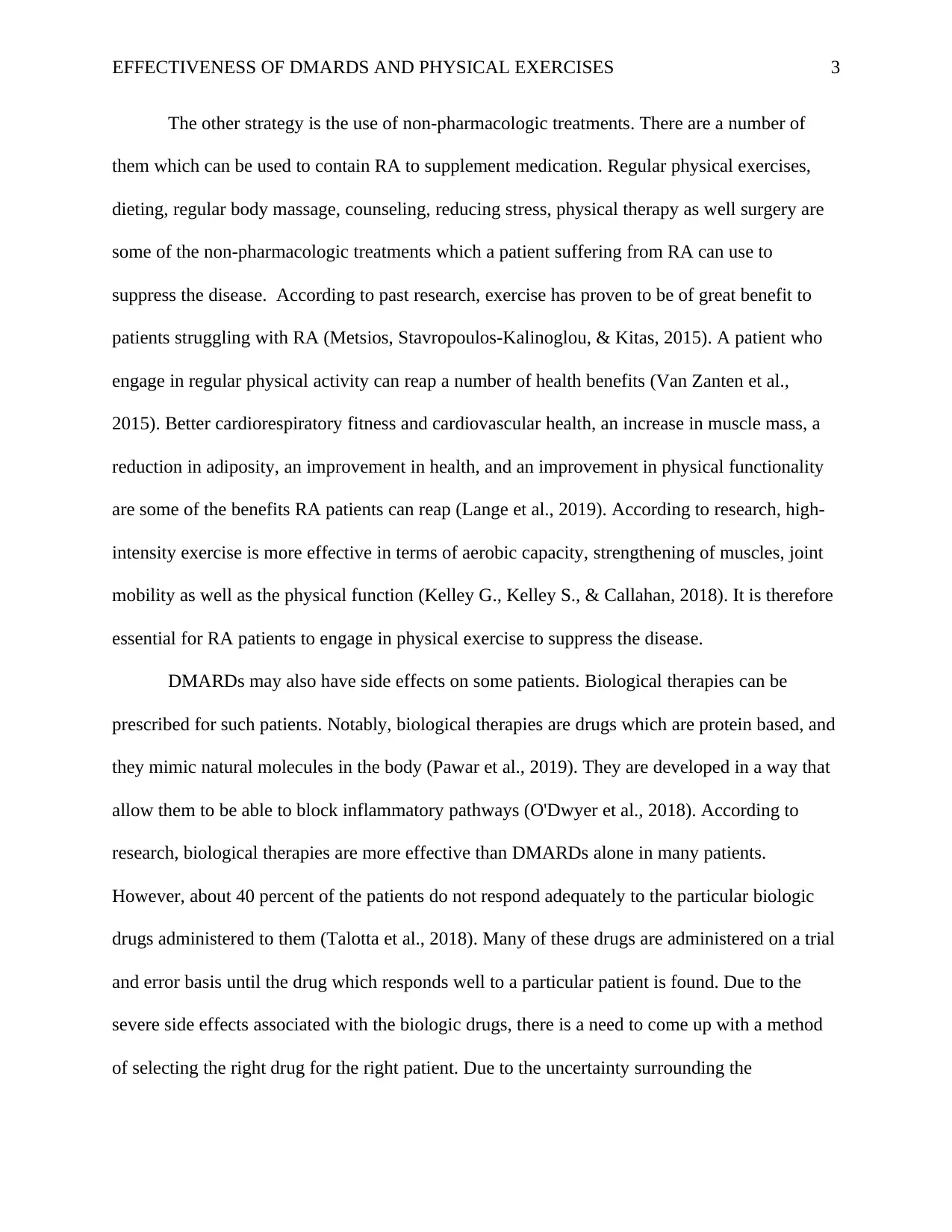
EFFECTIVENESS OF DMARDS AND PHYSICAL EXERCISES 3
The other strategy is the use of non-pharmacologic treatments. There are a number of
them which can be used to contain RA to supplement medication. Regular physical exercises,
dieting, regular body massage, counseling, reducing stress, physical therapy as well surgery are
some of the non-pharmacologic treatments which a patient suffering from RA can use to
suppress the disease. According to past research, exercise has proven to be of great benefit to
patients struggling with RA (Metsios, Stavropoulos-Kalinoglou, & Kitas, 2015). A patient who
engage in regular physical activity can reap a number of health benefits (Van Zanten et al.,
2015). Better cardiorespiratory fitness and cardiovascular health, an increase in muscle mass, a
reduction in adiposity, an improvement in health, and an improvement in physical functionality
are some of the benefits RA patients can reap (Lange et al., 2019). According to research, high-
intensity exercise is more effective in terms of aerobic capacity, strengthening of muscles, joint
mobility as well as the physical function (Kelley G., Kelley S., & Callahan, 2018). It is therefore
essential for RA patients to engage in physical exercise to suppress the disease.
DMARDs may also have side effects on some patients. Biological therapies can be
prescribed for such patients. Notably, biological therapies are drugs which are protein based, and
they mimic natural molecules in the body (Pawar et al., 2019). They are developed in a way that
allow them to be able to block inflammatory pathways (O'Dwyer et al., 2018). According to
research, biological therapies are more effective than DMARDs alone in many patients.
However, about 40 percent of the patients do not respond adequately to the particular biologic
drugs administered to them (Talotta et al., 2018). Many of these drugs are administered on a trial
and error basis until the drug which responds well to a particular patient is found. Due to the
severe side effects associated with the biologic drugs, there is a need to come up with a method
of selecting the right drug for the right patient. Due to the uncertainty surrounding the
The other strategy is the use of non-pharmacologic treatments. There are a number of
them which can be used to contain RA to supplement medication. Regular physical exercises,
dieting, regular body massage, counseling, reducing stress, physical therapy as well surgery are
some of the non-pharmacologic treatments which a patient suffering from RA can use to
suppress the disease. According to past research, exercise has proven to be of great benefit to
patients struggling with RA (Metsios, Stavropoulos-Kalinoglou, & Kitas, 2015). A patient who
engage in regular physical activity can reap a number of health benefits (Van Zanten et al.,
2015). Better cardiorespiratory fitness and cardiovascular health, an increase in muscle mass, a
reduction in adiposity, an improvement in health, and an improvement in physical functionality
are some of the benefits RA patients can reap (Lange et al., 2019). According to research, high-
intensity exercise is more effective in terms of aerobic capacity, strengthening of muscles, joint
mobility as well as the physical function (Kelley G., Kelley S., & Callahan, 2018). It is therefore
essential for RA patients to engage in physical exercise to suppress the disease.
DMARDs may also have side effects on some patients. Biological therapies can be
prescribed for such patients. Notably, biological therapies are drugs which are protein based, and
they mimic natural molecules in the body (Pawar et al., 2019). They are developed in a way that
allow them to be able to block inflammatory pathways (O'Dwyer et al., 2018). According to
research, biological therapies are more effective than DMARDs alone in many patients.
However, about 40 percent of the patients do not respond adequately to the particular biologic
drugs administered to them (Talotta et al., 2018). Many of these drugs are administered on a trial
and error basis until the drug which responds well to a particular patient is found. Due to the
severe side effects associated with the biologic drugs, there is a need to come up with a method
of selecting the right drug for the right patient. Due to the uncertainty surrounding the
⊘ This is a preview!⊘
Do you want full access?
Subscribe today to unlock all pages.

Trusted by 1+ million students worldwide
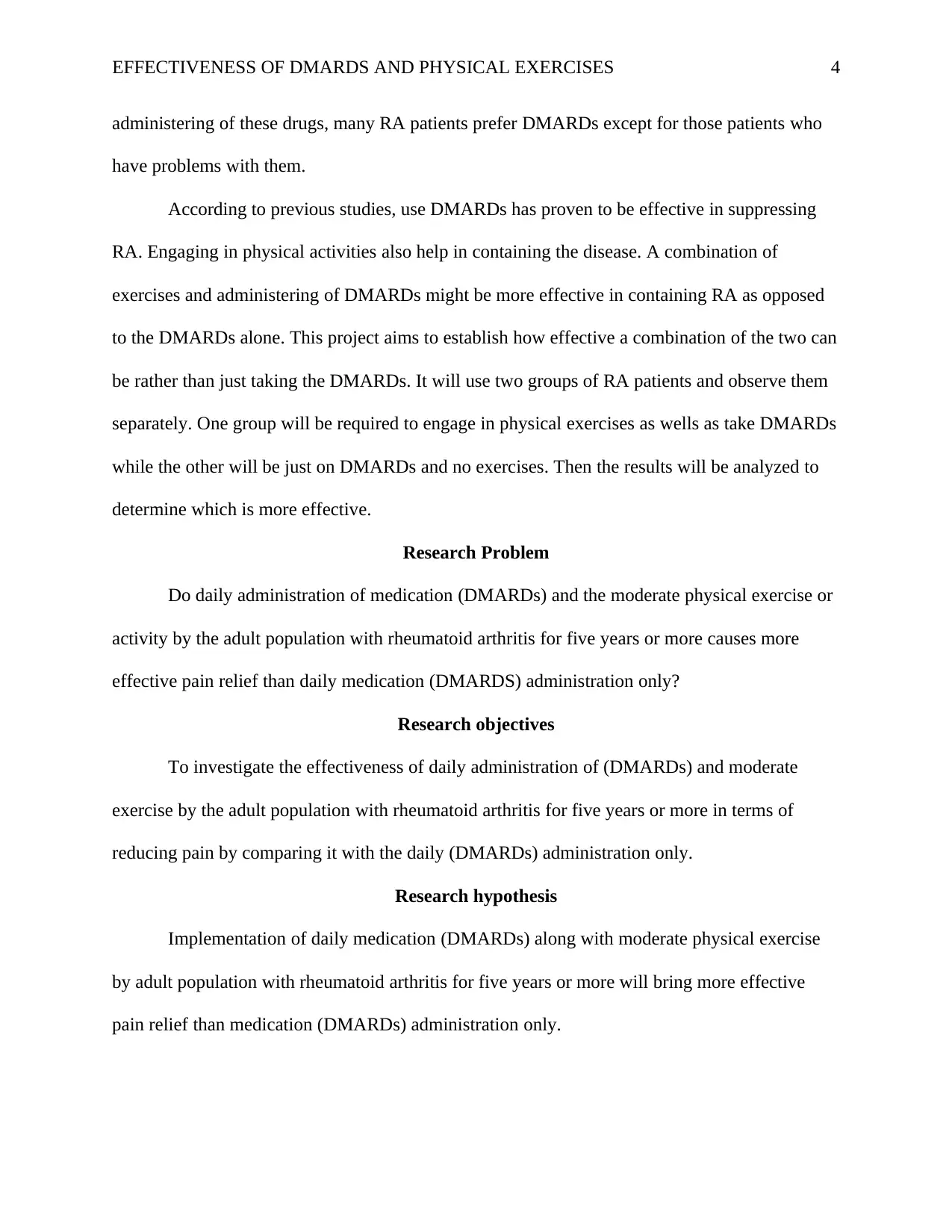
EFFECTIVENESS OF DMARDS AND PHYSICAL EXERCISES 4
administering of these drugs, many RA patients prefer DMARDs except for those patients who
have problems with them.
According to previous studies, use DMARDs has proven to be effective in suppressing
RA. Engaging in physical activities also help in containing the disease. A combination of
exercises and administering of DMARDs might be more effective in containing RA as opposed
to the DMARDs alone. This project aims to establish how effective a combination of the two can
be rather than just taking the DMARDs. It will use two groups of RA patients and observe them
separately. One group will be required to engage in physical exercises as wells as take DMARDs
while the other will be just on DMARDs and no exercises. Then the results will be analyzed to
determine which is more effective.
Research Problem
Do daily administration of medication (DMARDs) and the moderate physical exercise or
activity by the adult population with rheumatoid arthritis for five years or more causes more
effective pain relief than daily medication (DMARDS) administration only?
Research objectives
To investigate the effectiveness of daily administration of (DMARDs) and moderate
exercise by the adult population with rheumatoid arthritis for five years or more in terms of
reducing pain by comparing it with the daily (DMARDs) administration only.
Research hypothesis
Implementation of daily medication (DMARDs) along with moderate physical exercise
by adult population with rheumatoid arthritis for five years or more will bring more effective
pain relief than medication (DMARDs) administration only.
administering of these drugs, many RA patients prefer DMARDs except for those patients who
have problems with them.
According to previous studies, use DMARDs has proven to be effective in suppressing
RA. Engaging in physical activities also help in containing the disease. A combination of
exercises and administering of DMARDs might be more effective in containing RA as opposed
to the DMARDs alone. This project aims to establish how effective a combination of the two can
be rather than just taking the DMARDs. It will use two groups of RA patients and observe them
separately. One group will be required to engage in physical exercises as wells as take DMARDs
while the other will be just on DMARDs and no exercises. Then the results will be analyzed to
determine which is more effective.
Research Problem
Do daily administration of medication (DMARDs) and the moderate physical exercise or
activity by the adult population with rheumatoid arthritis for five years or more causes more
effective pain relief than daily medication (DMARDS) administration only?
Research objectives
To investigate the effectiveness of daily administration of (DMARDs) and moderate
exercise by the adult population with rheumatoid arthritis for five years or more in terms of
reducing pain by comparing it with the daily (DMARDs) administration only.
Research hypothesis
Implementation of daily medication (DMARDs) along with moderate physical exercise
by adult population with rheumatoid arthritis for five years or more will bring more effective
pain relief than medication (DMARDs) administration only.
Paraphrase This Document
Need a fresh take? Get an instant paraphrase of this document with our AI Paraphraser
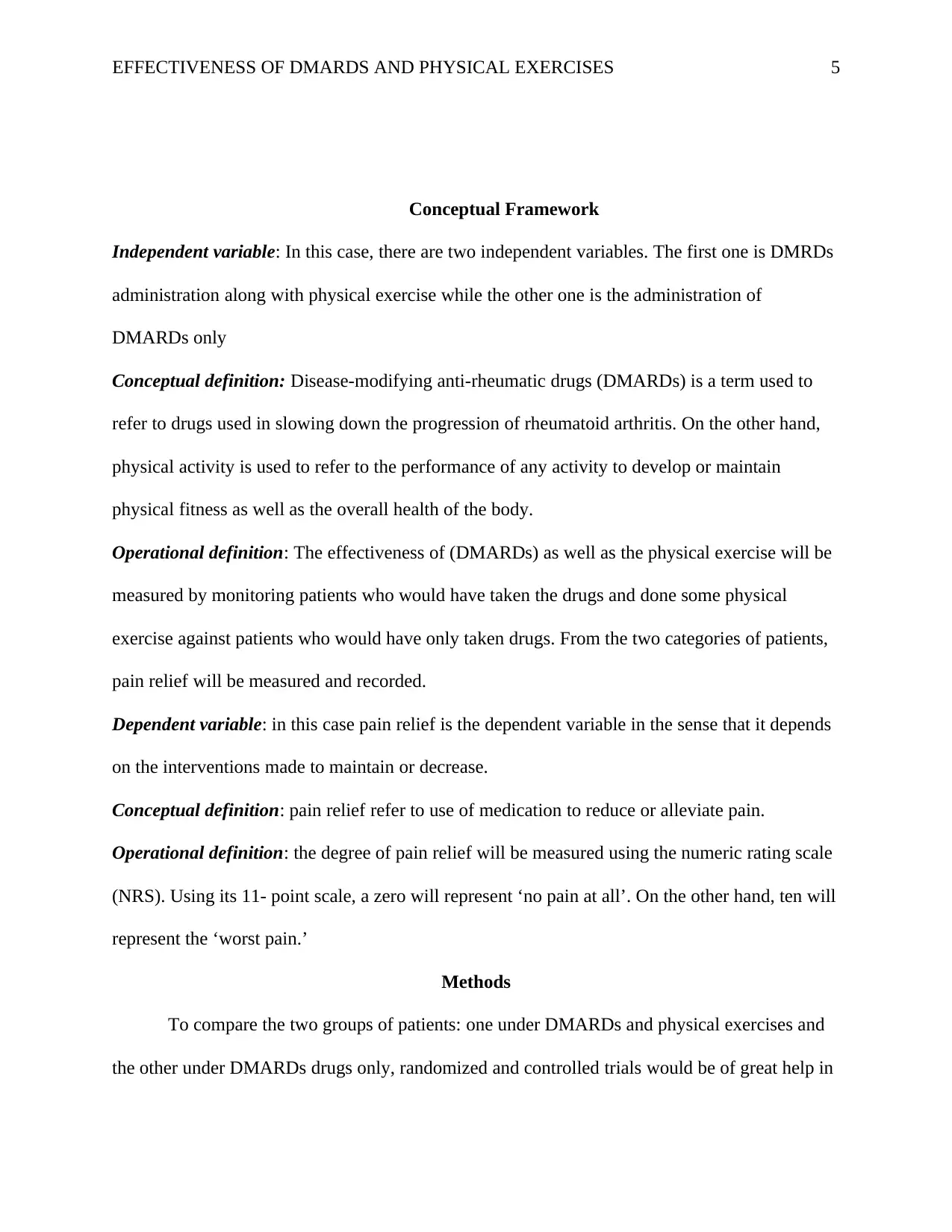
EFFECTIVENESS OF DMARDS AND PHYSICAL EXERCISES 5
Conceptual Framework
Independent variable: In this case, there are two independent variables. The first one is DMRDs
administration along with physical exercise while the other one is the administration of
DMARDs only
Conceptual definition: Disease-modifying anti-rheumatic drugs (DMARDs) is a term used to
refer to drugs used in slowing down the progression of rheumatoid arthritis. On the other hand,
physical activity is used to refer to the performance of any activity to develop or maintain
physical fitness as well as the overall health of the body.
Operational definition: The effectiveness of (DMARDs) as well as the physical exercise will be
measured by monitoring patients who would have taken the drugs and done some physical
exercise against patients who would have only taken drugs. From the two categories of patients,
pain relief will be measured and recorded.
Dependent variable: in this case pain relief is the dependent variable in the sense that it depends
on the interventions made to maintain or decrease.
Conceptual definition: pain relief refer to use of medication to reduce or alleviate pain.
Operational definition: the degree of pain relief will be measured using the numeric rating scale
(NRS). Using its 11- point scale, a zero will represent ‘no pain at all’. On the other hand, ten will
represent the ‘worst pain.’
Methods
To compare the two groups of patients: one under DMARDs and physical exercises and
the other under DMARDs drugs only, randomized and controlled trials would be of great help in
Conceptual Framework
Independent variable: In this case, there are two independent variables. The first one is DMRDs
administration along with physical exercise while the other one is the administration of
DMARDs only
Conceptual definition: Disease-modifying anti-rheumatic drugs (DMARDs) is a term used to
refer to drugs used in slowing down the progression of rheumatoid arthritis. On the other hand,
physical activity is used to refer to the performance of any activity to develop or maintain
physical fitness as well as the overall health of the body.
Operational definition: The effectiveness of (DMARDs) as well as the physical exercise will be
measured by monitoring patients who would have taken the drugs and done some physical
exercise against patients who would have only taken drugs. From the two categories of patients,
pain relief will be measured and recorded.
Dependent variable: in this case pain relief is the dependent variable in the sense that it depends
on the interventions made to maintain or decrease.
Conceptual definition: pain relief refer to use of medication to reduce or alleviate pain.
Operational definition: the degree of pain relief will be measured using the numeric rating scale
(NRS). Using its 11- point scale, a zero will represent ‘no pain at all’. On the other hand, ten will
represent the ‘worst pain.’
Methods
To compare the two groups of patients: one under DMARDs and physical exercises and
the other under DMARDs drugs only, randomized and controlled trials would be of great help in
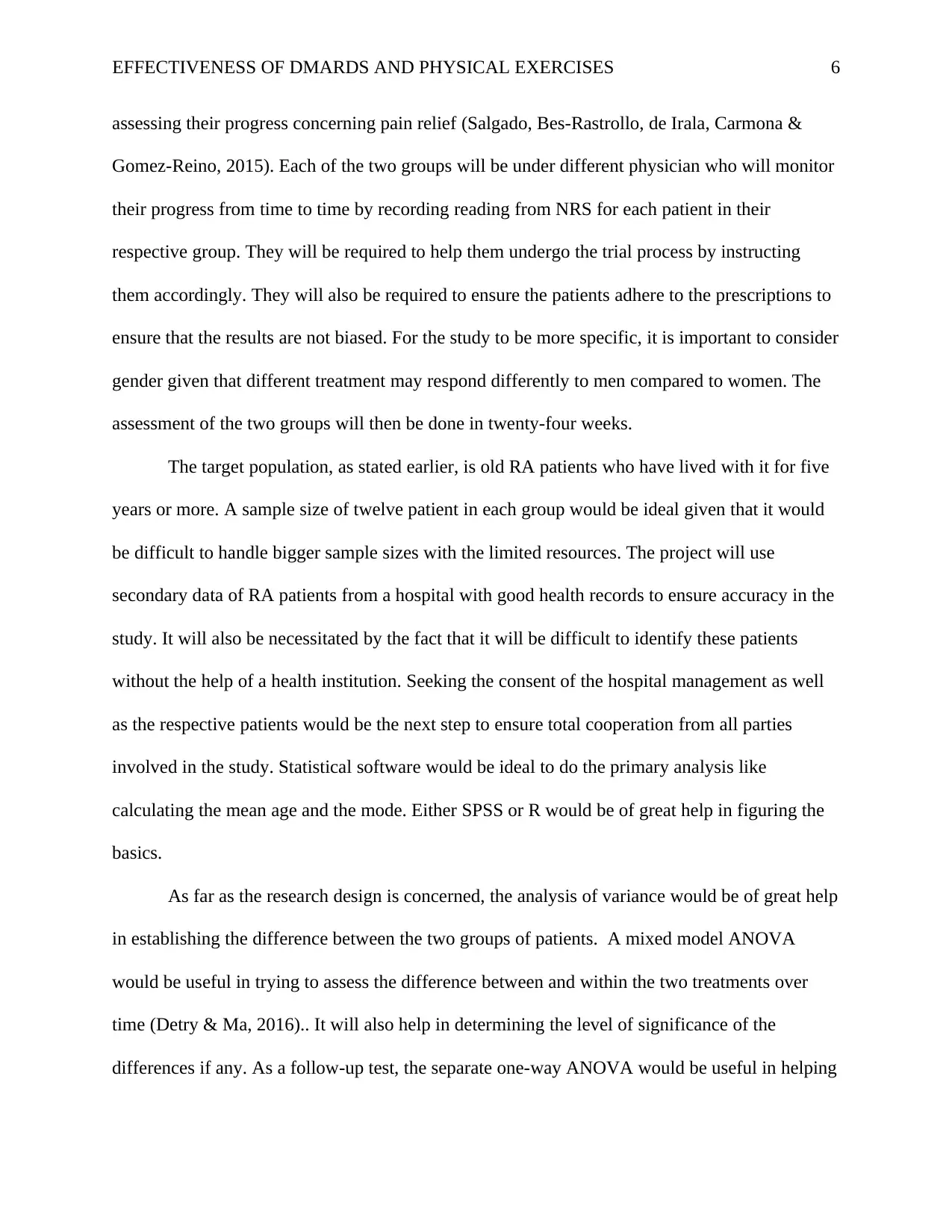
EFFECTIVENESS OF DMARDS AND PHYSICAL EXERCISES 6
assessing their progress concerning pain relief (Salgado, Bes-Rastrollo, de Irala, Carmona &
Gomez-Reino, 2015). Each of the two groups will be under different physician who will monitor
their progress from time to time by recording reading from NRS for each patient in their
respective group. They will be required to help them undergo the trial process by instructing
them accordingly. They will also be required to ensure the patients adhere to the prescriptions to
ensure that the results are not biased. For the study to be more specific, it is important to consider
gender given that different treatment may respond differently to men compared to women. The
assessment of the two groups will then be done in twenty-four weeks.
The target population, as stated earlier, is old RA patients who have lived with it for five
years or more. A sample size of twelve patient in each group would be ideal given that it would
be difficult to handle bigger sample sizes with the limited resources. The project will use
secondary data of RA patients from a hospital with good health records to ensure accuracy in the
study. It will also be necessitated by the fact that it will be difficult to identify these patients
without the help of a health institution. Seeking the consent of the hospital management as well
as the respective patients would be the next step to ensure total cooperation from all parties
involved in the study. Statistical software would be ideal to do the primary analysis like
calculating the mean age and the mode. Either SPSS or R would be of great help in figuring the
basics.
As far as the research design is concerned, the analysis of variance would be of great help
in establishing the difference between the two groups of patients. A mixed model ANOVA
would be useful in trying to assess the difference between and within the two treatments over
time (Detry & Ma, 2016).. It will also help in determining the level of significance of the
differences if any. As a follow-up test, the separate one-way ANOVA would be useful in helping
assessing their progress concerning pain relief (Salgado, Bes-Rastrollo, de Irala, Carmona &
Gomez-Reino, 2015). Each of the two groups will be under different physician who will monitor
their progress from time to time by recording reading from NRS for each patient in their
respective group. They will be required to help them undergo the trial process by instructing
them accordingly. They will also be required to ensure the patients adhere to the prescriptions to
ensure that the results are not biased. For the study to be more specific, it is important to consider
gender given that different treatment may respond differently to men compared to women. The
assessment of the two groups will then be done in twenty-four weeks.
The target population, as stated earlier, is old RA patients who have lived with it for five
years or more. A sample size of twelve patient in each group would be ideal given that it would
be difficult to handle bigger sample sizes with the limited resources. The project will use
secondary data of RA patients from a hospital with good health records to ensure accuracy in the
study. It will also be necessitated by the fact that it will be difficult to identify these patients
without the help of a health institution. Seeking the consent of the hospital management as well
as the respective patients would be the next step to ensure total cooperation from all parties
involved in the study. Statistical software would be ideal to do the primary analysis like
calculating the mean age and the mode. Either SPSS or R would be of great help in figuring the
basics.
As far as the research design is concerned, the analysis of variance would be of great help
in establishing the difference between the two groups of patients. A mixed model ANOVA
would be useful in trying to assess the difference between and within the two treatments over
time (Detry & Ma, 2016).. It will also help in determining the level of significance of the
differences if any. As a follow-up test, the separate one-way ANOVA would be useful in helping
⊘ This is a preview!⊘
Do you want full access?
Subscribe today to unlock all pages.

Trusted by 1+ million students worldwide
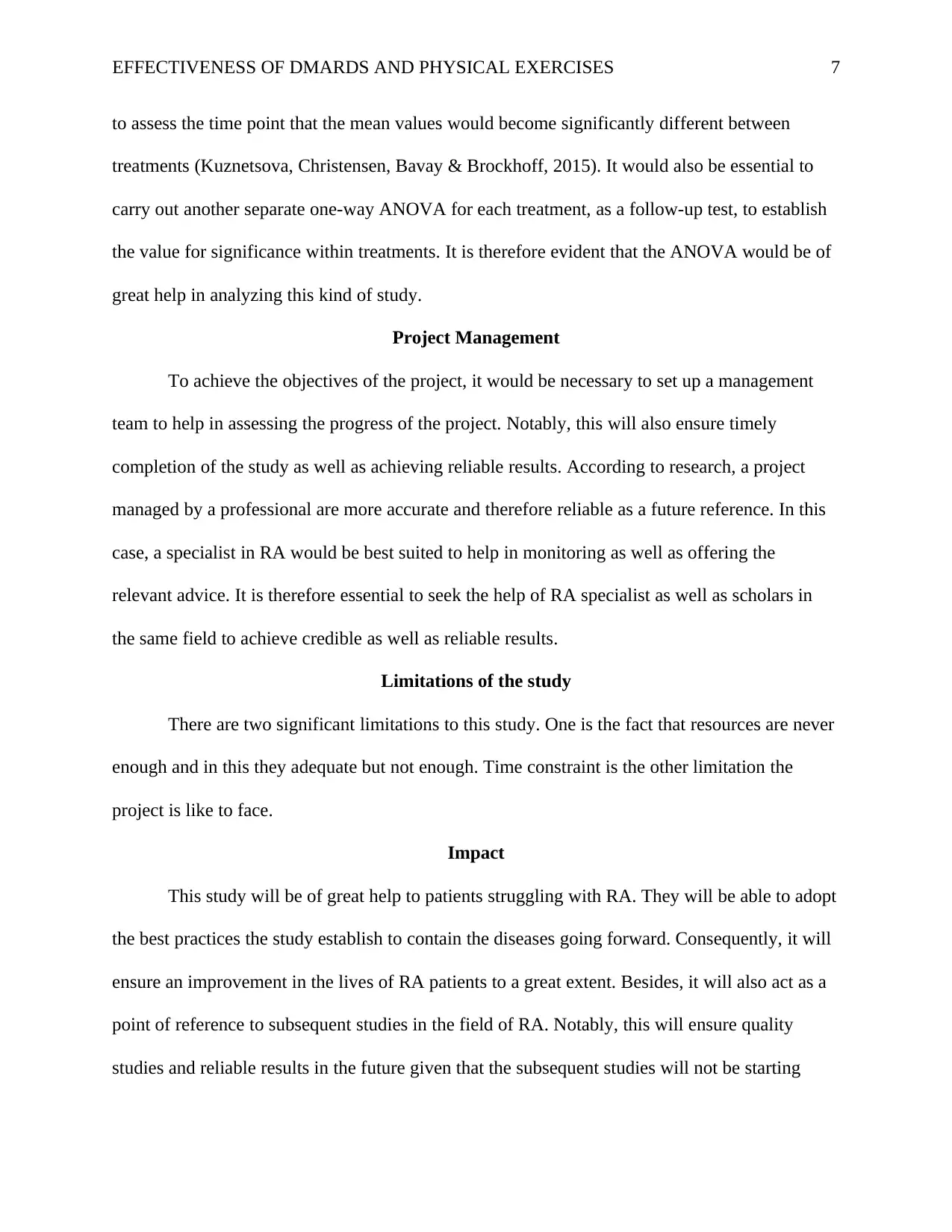
EFFECTIVENESS OF DMARDS AND PHYSICAL EXERCISES 7
to assess the time point that the mean values would become significantly different between
treatments (Kuznetsova, Christensen, Bavay & Brockhoff, 2015). It would also be essential to
carry out another separate one-way ANOVA for each treatment, as a follow-up test, to establish
the value for significance within treatments. It is therefore evident that the ANOVA would be of
great help in analyzing this kind of study.
Project Management
To achieve the objectives of the project, it would be necessary to set up a management
team to help in assessing the progress of the project. Notably, this will also ensure timely
completion of the study as well as achieving reliable results. According to research, a project
managed by a professional are more accurate and therefore reliable as a future reference. In this
case, a specialist in RA would be best suited to help in monitoring as well as offering the
relevant advice. It is therefore essential to seek the help of RA specialist as well as scholars in
the same field to achieve credible as well as reliable results.
Limitations of the study
There are two significant limitations to this study. One is the fact that resources are never
enough and in this they adequate but not enough. Time constraint is the other limitation the
project is like to face.
Impact
This study will be of great help to patients struggling with RA. They will be able to adopt
the best practices the study establish to contain the diseases going forward. Consequently, it will
ensure an improvement in the lives of RA patients to a great extent. Besides, it will also act as a
point of reference to subsequent studies in the field of RA. Notably, this will ensure quality
studies and reliable results in the future given that the subsequent studies will not be starting
to assess the time point that the mean values would become significantly different between
treatments (Kuznetsova, Christensen, Bavay & Brockhoff, 2015). It would also be essential to
carry out another separate one-way ANOVA for each treatment, as a follow-up test, to establish
the value for significance within treatments. It is therefore evident that the ANOVA would be of
great help in analyzing this kind of study.
Project Management
To achieve the objectives of the project, it would be necessary to set up a management
team to help in assessing the progress of the project. Notably, this will also ensure timely
completion of the study as well as achieving reliable results. According to research, a project
managed by a professional are more accurate and therefore reliable as a future reference. In this
case, a specialist in RA would be best suited to help in monitoring as well as offering the
relevant advice. It is therefore essential to seek the help of RA specialist as well as scholars in
the same field to achieve credible as well as reliable results.
Limitations of the study
There are two significant limitations to this study. One is the fact that resources are never
enough and in this they adequate but not enough. Time constraint is the other limitation the
project is like to face.
Impact
This study will be of great help to patients struggling with RA. They will be able to adopt
the best practices the study establish to contain the diseases going forward. Consequently, it will
ensure an improvement in the lives of RA patients to a great extent. Besides, it will also act as a
point of reference to subsequent studies in the field of RA. Notably, this will ensure quality
studies and reliable results in the future given that the subsequent studies will not be starting
Paraphrase This Document
Need a fresh take? Get an instant paraphrase of this document with our AI Paraphraser

EFFECTIVENESS OF DMARDS AND PHYSICAL EXERCISES 8
from scratch. According to research, previous studies, have been vital in informing subsequent
decisions, especially in the field of health care (Benchimol et al., 2015). It would be therefore
necessary to carry out the study diligently to ensure no incidences of wrong treatment in the
future. A good study would also provide a solution to a vast number of patients struggling with
RA all over the world.
from scratch. According to research, previous studies, have been vital in informing subsequent
decisions, especially in the field of health care (Benchimol et al., 2015). It would be therefore
necessary to carry out the study diligently to ensure no incidences of wrong treatment in the
future. A good study would also provide a solution to a vast number of patients struggling with
RA all over the world.
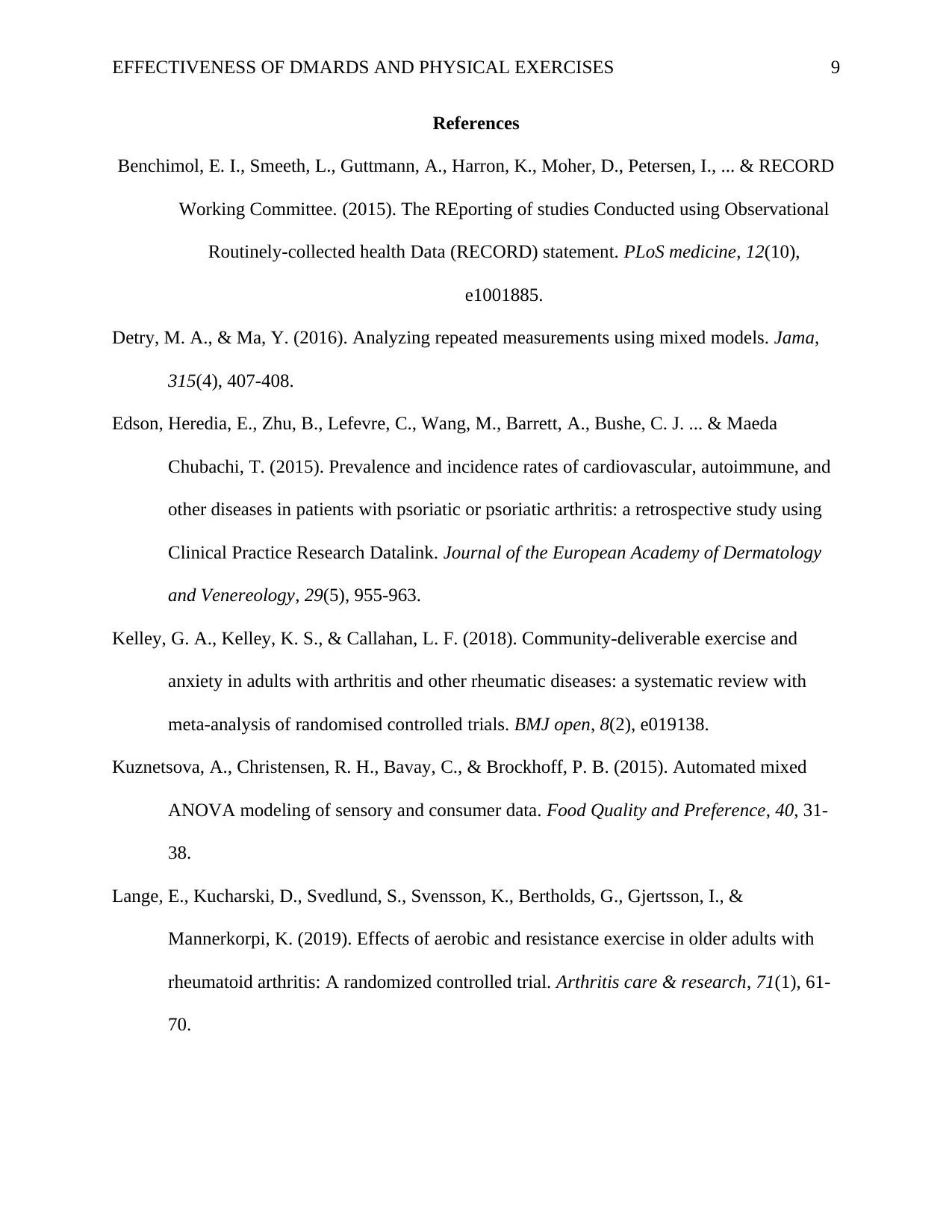
EFFECTIVENESS OF DMARDS AND PHYSICAL EXERCISES 9
References
Benchimol, E. I., Smeeth, L., Guttmann, A., Harron, K., Moher, D., Petersen, I., ... & RECORD
Working Committee. (2015). The REporting of studies Conducted using Observational
Routinely-collected health Data (RECORD) statement. PLoS medicine, 12(10),
e1001885.
Detry, M. A., & Ma, Y. (2016). Analyzing repeated measurements using mixed models. Jama,
315(4), 407-408.
Edson, Heredia, E., Zhu, B., Lefevre, C., Wang, M., Barrett, A., Bushe, C. J. ... & Maeda
Chubachi, T. (2015). Prevalence and incidence rates of cardiovascular, autoimmune, and
other diseases in patients with psoriatic or psoriatic arthritis: a retrospective study using
Clinical Practice Research Datalink. Journal of the European Academy of Dermatology
and Venereology, 29(5), 955-963.
Kelley, G. A., Kelley, K. S., & Callahan, L. F. (2018). Community-deliverable exercise and
anxiety in adults with arthritis and other rheumatic diseases: a systematic review with
meta-analysis of randomised controlled trials. BMJ open, 8(2), e019138.
Kuznetsova, A., Christensen, R. H., Bavay, C., & Brockhoff, P. B. (2015). Automated mixed
ANOVA modeling of sensory and consumer data. Food Quality and Preference, 40, 31-
38.
Lange, E., Kucharski, D., Svedlund, S., Svensson, K., Bertholds, G., Gjertsson, I., &
Mannerkorpi, K. (2019). Effects of aerobic and resistance exercise in older adults with
rheumatoid arthritis: A randomized controlled trial. Arthritis care & research, 71(1), 61-
70.
References
Benchimol, E. I., Smeeth, L., Guttmann, A., Harron, K., Moher, D., Petersen, I., ... & RECORD
Working Committee. (2015). The REporting of studies Conducted using Observational
Routinely-collected health Data (RECORD) statement. PLoS medicine, 12(10),
e1001885.
Detry, M. A., & Ma, Y. (2016). Analyzing repeated measurements using mixed models. Jama,
315(4), 407-408.
Edson, Heredia, E., Zhu, B., Lefevre, C., Wang, M., Barrett, A., Bushe, C. J. ... & Maeda
Chubachi, T. (2015). Prevalence and incidence rates of cardiovascular, autoimmune, and
other diseases in patients with psoriatic or psoriatic arthritis: a retrospective study using
Clinical Practice Research Datalink. Journal of the European Academy of Dermatology
and Venereology, 29(5), 955-963.
Kelley, G. A., Kelley, K. S., & Callahan, L. F. (2018). Community-deliverable exercise and
anxiety in adults with arthritis and other rheumatic diseases: a systematic review with
meta-analysis of randomised controlled trials. BMJ open, 8(2), e019138.
Kuznetsova, A., Christensen, R. H., Bavay, C., & Brockhoff, P. B. (2015). Automated mixed
ANOVA modeling of sensory and consumer data. Food Quality and Preference, 40, 31-
38.
Lange, E., Kucharski, D., Svedlund, S., Svensson, K., Bertholds, G., Gjertsson, I., &
Mannerkorpi, K. (2019). Effects of aerobic and resistance exercise in older adults with
rheumatoid arthritis: A randomized controlled trial. Arthritis care & research, 71(1), 61-
70.
⊘ This is a preview!⊘
Do you want full access?
Subscribe today to unlock all pages.

Trusted by 1+ million students worldwide
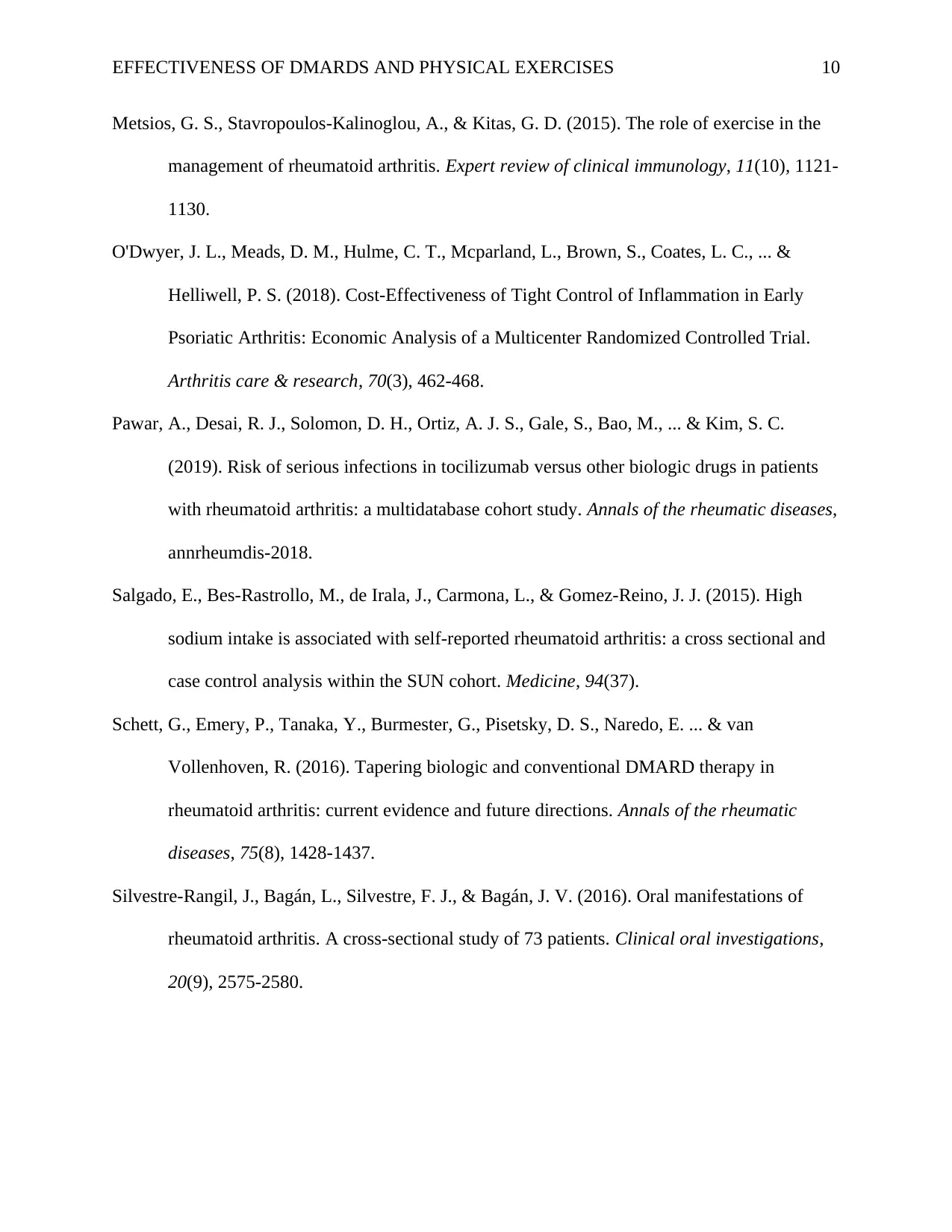
EFFECTIVENESS OF DMARDS AND PHYSICAL EXERCISES 10
Metsios, G. S., Stavropoulos-Kalinoglou, A., & Kitas, G. D. (2015). The role of exercise in the
management of rheumatoid arthritis. Expert review of clinical immunology, 11(10), 1121-
1130.
O'Dwyer, J. L., Meads, D. M., Hulme, C. T., Mcparland, L., Brown, S., Coates, L. C., ... &
Helliwell, P. S. (2018). Cost‐Effectiveness of Tight Control of Inflammation in Early
Psoriatic Arthritis: Economic Analysis of a Multicenter Randomized Controlled Trial.
Arthritis care & research, 70(3), 462-468.
Pawar, A., Desai, R. J., Solomon, D. H., Ortiz, A. J. S., Gale, S., Bao, M., ... & Kim, S. C.
(2019). Risk of serious infections in tocilizumab versus other biologic drugs in patients
with rheumatoid arthritis: a multidatabase cohort study. Annals of the rheumatic diseases,
annrheumdis-2018.
Salgado, E., Bes-Rastrollo, M., de Irala, J., Carmona, L., & Gomez-Reino, J. J. (2015). High
sodium intake is associated with self-reported rheumatoid arthritis: a cross sectional and
case control analysis within the SUN cohort. Medicine, 94(37).
Schett, G., Emery, P., Tanaka, Y., Burmester, G., Pisetsky, D. S., Naredo, E. ... & van
Vollenhoven, R. (2016). Tapering biologic and conventional DMARD therapy in
rheumatoid arthritis: current evidence and future directions. Annals of the rheumatic
diseases, 75(8), 1428-1437.
Silvestre-Rangil, J., Bagán, L., Silvestre, F. J., & Bagán, J. V. (2016). Oral manifestations of
rheumatoid arthritis. A cross-sectional study of 73 patients. Clinical oral investigations,
20(9), 2575-2580.
Metsios, G. S., Stavropoulos-Kalinoglou, A., & Kitas, G. D. (2015). The role of exercise in the
management of rheumatoid arthritis. Expert review of clinical immunology, 11(10), 1121-
1130.
O'Dwyer, J. L., Meads, D. M., Hulme, C. T., Mcparland, L., Brown, S., Coates, L. C., ... &
Helliwell, P. S. (2018). Cost‐Effectiveness of Tight Control of Inflammation in Early
Psoriatic Arthritis: Economic Analysis of a Multicenter Randomized Controlled Trial.
Arthritis care & research, 70(3), 462-468.
Pawar, A., Desai, R. J., Solomon, D. H., Ortiz, A. J. S., Gale, S., Bao, M., ... & Kim, S. C.
(2019). Risk of serious infections in tocilizumab versus other biologic drugs in patients
with rheumatoid arthritis: a multidatabase cohort study. Annals of the rheumatic diseases,
annrheumdis-2018.
Salgado, E., Bes-Rastrollo, M., de Irala, J., Carmona, L., & Gomez-Reino, J. J. (2015). High
sodium intake is associated with self-reported rheumatoid arthritis: a cross sectional and
case control analysis within the SUN cohort. Medicine, 94(37).
Schett, G., Emery, P., Tanaka, Y., Burmester, G., Pisetsky, D. S., Naredo, E. ... & van
Vollenhoven, R. (2016). Tapering biologic and conventional DMARD therapy in
rheumatoid arthritis: current evidence and future directions. Annals of the rheumatic
diseases, 75(8), 1428-1437.
Silvestre-Rangil, J., Bagán, L., Silvestre, F. J., & Bagán, J. V. (2016). Oral manifestations of
rheumatoid arthritis. A cross-sectional study of 73 patients. Clinical oral investigations,
20(9), 2575-2580.
Paraphrase This Document
Need a fresh take? Get an instant paraphrase of this document with our AI Paraphraser
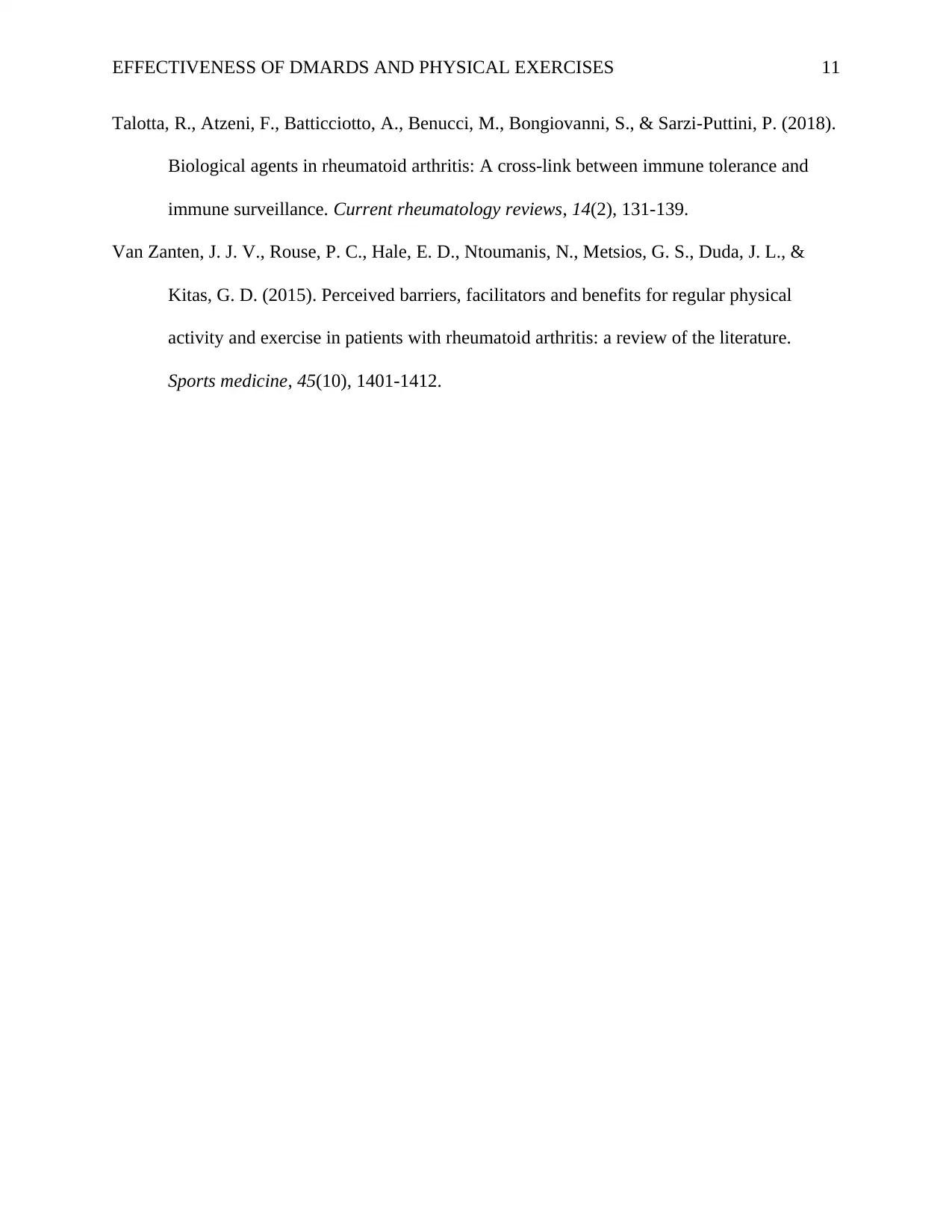
EFFECTIVENESS OF DMARDS AND PHYSICAL EXERCISES 11
Talotta, R., Atzeni, F., Batticciotto, A., Benucci, M., Bongiovanni, S., & Sarzi-Puttini, P. (2018).
Biological agents in rheumatoid arthritis: A cross-link between immune tolerance and
immune surveillance. Current rheumatology reviews, 14(2), 131-139.
Van Zanten, J. J. V., Rouse, P. C., Hale, E. D., Ntoumanis, N., Metsios, G. S., Duda, J. L., &
Kitas, G. D. (2015). Perceived barriers, facilitators and benefits for regular physical
activity and exercise in patients with rheumatoid arthritis: a review of the literature.
Sports medicine, 45(10), 1401-1412.
Talotta, R., Atzeni, F., Batticciotto, A., Benucci, M., Bongiovanni, S., & Sarzi-Puttini, P. (2018).
Biological agents in rheumatoid arthritis: A cross-link between immune tolerance and
immune surveillance. Current rheumatology reviews, 14(2), 131-139.
Van Zanten, J. J. V., Rouse, P. C., Hale, E. D., Ntoumanis, N., Metsios, G. S., Duda, J. L., &
Kitas, G. D. (2015). Perceived barriers, facilitators and benefits for regular physical
activity and exercise in patients with rheumatoid arthritis: a review of the literature.
Sports medicine, 45(10), 1401-1412.
1 out of 11
Related Documents
Your All-in-One AI-Powered Toolkit for Academic Success.
+13062052269
info@desklib.com
Available 24*7 on WhatsApp / Email
![[object Object]](/_next/static/media/star-bottom.7253800d.svg)
Unlock your academic potential
Copyright © 2020–2025 A2Z Services. All Rights Reserved. Developed and managed by ZUCOL.





